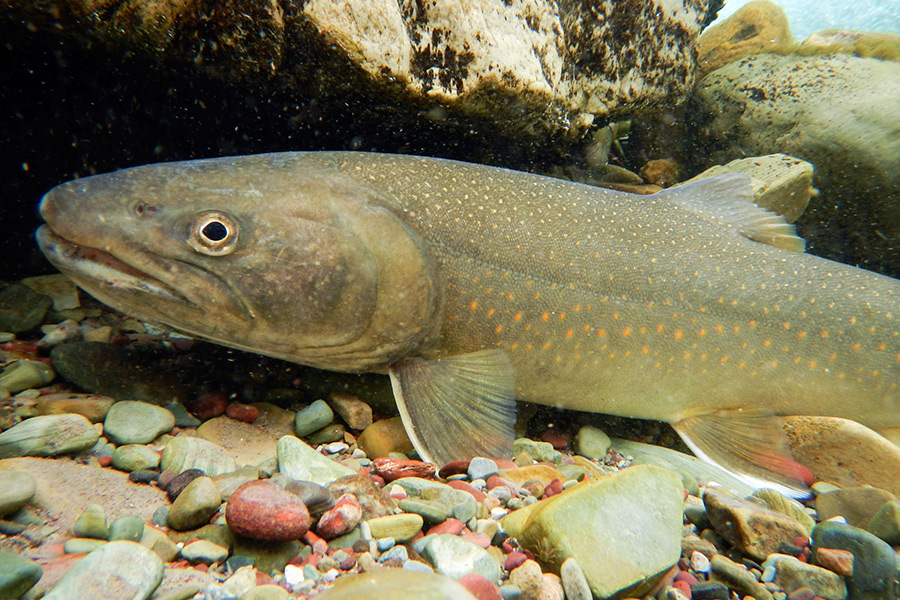Lake trout populations exploded after the state introduced mysis shrimp into the upper Flathead Drainage in 1968, and appeared in Flathead Lake in 1981. The increase in non-native lake trout led to the collapse of the kokanee salmon fishery and steep declines in native fish, including bull and cutthroat trout.
It’s an oft-cited example by local fisheries managers and conservationists to illustrate how invasive species erode biodiversity and lead to steep economic losses, including about $120 billion in annual damages in the U.S. alone.
Despite an abundance of evidence showing that invasive species can alter food webs, however, the ways in which invaders disrupt food webs and native species through time has remained unclear.
Until now.
A new collaborative study conducted by researchers representing the University of Montana’s Flathead Lake Biological Station (FLBS), U.S. Geological Survey (USGS), and Montana Fish, Wildlife & Parks, provides new insight into how invasive species progressively affect native food webs.
“This study provides new details about how invasive lake trout affect entire lake food webs,” said U.S. Fish and Wildlife Service biologist Charles Wainright, who recently completed his graduate student work at FLBS. “The findings will be important for conserving native species and ecosystems in Montana and elsewhere.”
The study, recently published in the prestigious journal Proceedings of the National Academy of Sciences, used long-term fisheries monitoring records to determine the timing of invasion by a non-native fish predator, lake trout, in ten northwestern Montana lakes, and analyzed food webs from those lakes to determine how they changed and impacted native communities as their invasions progressed.
The research team showed that lake trout disrupted food webs by forcing native fish species to feed on suboptimal food sources in different habitats, eventually causing the loss of the native predator, bull trout, a threatened species protected under the U.S. Endangered Species Act.
“Native bull trout populations have drastically declined in many lakes across western Montana due to competitive interactions with invasive lake trout,” said USGS aquatic ecologist and FLBS associate research professor Clint Muhlfeld. “For the first time, we show what happens not only to bull trout but entire food webs supporting them as lake trout invade and upset lake ecosystems over time.”
The study also showed that the food web effects of lake trout invasion were especially pronounced as lake trout abundance increased rapidly 25 to 50 years after colonization. After 50 years, lake trout were the dominant apex predator in these food webs. The study shows that, given enough time, invasive lake trout can disrupt and replace a native fish species, like bull trout, and create divergent biological communities that are vastly different than uninvaded ecosystems.
This study adds to a body of evidence showing that invasive species have affected western Montana. For example, until the late 1800s, around 10 native species of fish patrolled the waters of Flathead Lake, including abundant westslope cutthroat trout and bull trout.
Beginning in 1905, fisheries managers began introducing nonnative species to the food web as a means to improve Flathead Lake tourism and generate more recreational fishing appeal.
Today, there are more than 20 species of fish in Flathead Lake, and introduced species like lake trout, lake whitefish, and Mysis shrimp, dominate the food web in Flathead Lake, so much so that native species — including bull trout and westslope cutthroat, Montana’s state fish — have declined dramatically.
“This has been a truly collaborative effort,” said FLBS lake ecologist Shawn Devlin. “The work leverages the rather bleak history of introduction and invasion of non-native species in northwest Montana lakes into an ecological experiment built on the power of long-term data and a deeper understanding of lake ecology.”
The study’s results stress the importance of protecting entire landscapes from biological invasions. The use of innovative biosurveillance monitoring techniques, like environmental DNA, are also critical to increase the likelihood of detecting invaders before they become established. For ecosystems that have already been invaded, this study’s findings can be used to inform proactive control efforts during the early stages of invasion to avoid food web disruptions that may be difficult to reverse.
The study was led by Wainwrght and co-authored by Muhlfeld, Devlin, FLBS Director Jim Elser, and Samuel Bourret of Montana Fish, Wildlife and Parks. The study was supported by the USGS Biological Threats Program, FLBS and philanthropic gifts.
